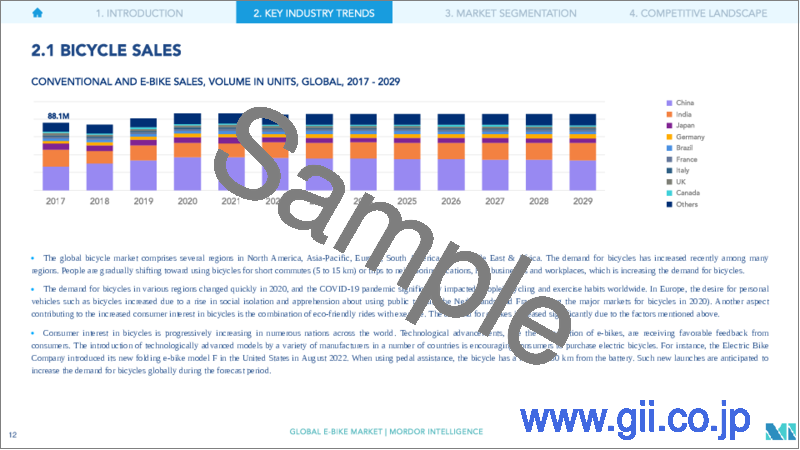|
|
市場調査レポート
商品コード
1683800
電動自転車:市場シェア分析、産業動向・統計、成長予測(2025年~2029年)E-bike - Market Share Analysis, Industry Trends & Statistics, Growth Forecasts (2025 - 2029) |
||||||
カスタマイズ可能
適宜更新あり
|
|||||||
| 電動自転車:市場シェア分析、産業動向・統計、成長予測(2025年~2029年) |
|
出版日: 2025年03月18日
発行: Mordor Intelligence
ページ情報: 英文 384 Pages
納期: 2~3営業日
|
- 全表示
- 概要
- 目次
電動自転車の市場規模は2025年に380億8,000万米ドルと推定され、2029年には517億8,000万米ドルに達すると予測され、予測期間中(2025-2029年)のCAGRは7.98%で成長します。

- 電動自転車は信頼性が高く、環境に有益です。また、自動車の快適さと走る楽しさを兼ね備えているため、レジャーに特に便利な交通手段でもあります。電動自転車は静かで、二酸化炭素を排出せず、安価な交通手段であり、スペースを節約し、優れた健康を促進します。市場成長の主な原動力は、フィットネスに対する意識の高まり、環境問題への関心の高まり、交通渋滞の増加、サイクリング促進のための政府の取り組みです。
- 電動自転車は、特にレクリエーション活動のための優れた移動手段です。これらの自転車は、電動エンジンなしには移動が困難な険しい地形でも横断することを可能にします。COVID-19が大流行した際、人々は安全で快適な移動手段を求め始め、電動自転車が通常の使用に組み込まれた結果、電動自転車ビジネスが増加しています。これらの要因により、世界中で電動自転車の人気が高まっています。
- 環境と健康に対する懸念がますます高まる中、世界中の政府や国際機関が二酸化炭素排出量を制限するための厳しい排出基準を可決しています。世界には厳しい車両基準を設けている国際機関もあります。化石燃料の埋蔵量が急速に枯渇していることから、将来世代の持続可能性に懸念が持たれています。この側面は、政府や社会に大きな課題を突きつけています。その結果、電動自転車はこの問題に対する優れた回答であることが証明されています。
国レベルの概要
- 市場の成長は主に、日常的な移動手段としての電動自転車の採用が世界的に増加していることによるものです。同市場では、健康上の利点、経済的な移動手段、乗車時の利便性など、消費者にとって有益な特性を持つ電動自転車の販売台数が急増しています。
- アジア太平洋の電動自転車または電動自転車市場では、中国、日本、インドネシアが歴史的期間に販売台数全体の大きなシェアを占めました。中国は2023年に世界の電動自転車市場で90%以上の数量シェアを占めました。しかし、近年は成長が停滞しており、市場はほぼ飽和状態にあります。
- 欧州では近年、電動自転車の販売台数が急増しており、ドイツ、ベルギー、オランダなどが主要な電動自転車を販売しています。この動向は、交通機関、スポーツ、レジャー活動で電動自転車が好まれるようになってきたことによる。スウェーデン、ベルギー、フランスにおける電動自転車に対する補助金や税制優遇プログラムは、予測期間中の欧州電動自転車市場の大幅な成長を支える可能性が高いです。
- 北米の電動自転車市場は、低速二輪車への嗜好が近年高まっていることから成長しています。さまざまなバイクシェアリング事業者が電動自転車をフリートに入れており、近い将来、これらのバイクの売上成長をサポートすると予想されます。
世界の電動自転車市場動向
電動自転車の世界の普及率の着実な増加は、持続可能で効率的なパーソナル・モビリティ・ソリューションへの世界のシフトを反映している
- ここ数年、多くの国で電動自転車の需要が増加しています。ガソリン代の上昇、ラッシュ時の交通渋滞、運動による健康上の利点が、英国や米国を含むいくつかの国々で電動自転車の採用を促進しています。他の地域と比較して2019年の導入率が高い欧州は、電動自転車販売の主要市場でした。電動自転車に対する需要の増加は、2018年と比較して2019年の採用率を加速させました。
- 自転車業界は、COVID-19ケースの急速な世界的拡大により好影響を受けました。電動自転車は、他の交通手段と比較して、毎日の通勤やその他の地域的な場所への移動に最も実用的で手頃な価格のソリューションの1つであり、消費者の通勤方法に革命をもたらしました。このことが人々の電動自転車への投資を促し、世界各国における2020年の電動自転車普及率は2019年よりも加速しました。
- 商業運転の再開とロックアウトなどの貿易規制の解除が、世界各国で電動自転車の普及を加速させました。輸出入活動の改善は、世界的に貿易障害が撤廃された結果です。推定・予測によると、予測期間中、乗りながら運動ができる、燃料費がかからない、乗り心地がよりクリーンであるなどの特徴や利点から、消費者の電動自転車への関心が高まり、世界の多くの国で電動自転車の普及率が高まる。
5~15kmの通勤距離が世界的に増加していることは、進化するワークライフダイナミクスと都市計画に沿った、適度な通勤距離への普遍的なシフトを浮き彫りにしている
- 世界の自転車市場は、北米、欧州、アジア太平洋など、自転車に親しんでいるいくつかの地域で構成されています。自転車需要は最近、さまざまな地域の多くの国で伸びています。さまざまな国や地域の人々が、5~15kmの日常的な通勤や、オフィスや商業地区など近隣の場所への移動に自転車を利用するようになりつつあります。アジア太平洋地域は、全地域の中で5~15kmの距離を毎日通勤する人が最も多い地域です。
- COVID-19の大流行後、世界数カ国でスポーツジムや公共交通機関の閉鎖を余儀なくされたが、多くの人々は自転車が安全で孤立した移動手段であることを知りました。また、パンデミックの間、人々は自転車や週末に近隣へ走りに行くことで運動することを好んだため、2020年には1日の移動距離が5~15kmの通勤者の数が2019年よりも世界的に増加しました。毎日5~15kmの距離を通勤する消費者は、最大40~45kmまで航続距離を伸ばせる最先端のバッテリーパックを搭載した電動自転車に惹かれています。
電動自転車産業の概要
電動自転車市場は細分化されており、上位5社で21.46%を占めています。この市場の主要企業は以下の通りです。Aima Technology Group, Giant Manufacturing, Merida Industry, Trek Bicycle Corporation and Yadea Group Holdings Ltd(sorted alphabetically).
その他の特典
- エクセル形式の市場予測(ME)シート
- 3ヶ月のアナリストサポート
目次
第1章 エグゼクティブサマリーと主な調査結果
第2章 レポートのオファー
第3章 イントロダクション
- 調査の前提条件と市場定義
- 調査範囲
- 調査手法
第4章 主要産業動向
- 自転車販売台数
- 一人当たりGDP
- インフレ率
- 電子自転車の普及率
- 1日の移動距離が5~15キロの人口/通勤者の割合
- レンタサイクル
- 電動自転車バッテリー価格
- バッテリー化学の価格表
- 超ローカル配送
- 自転車専用レーン
- トレッカー数
- バッテリー充電能力
- 交通渋滞指数
- 規制の枠組み
- バリューチェーンと流通チャネル分析
第5章 市場セグメンテーション
- 推進タイプ
- ペダルアシスト
- スピードペデレック
- スロットルアシスト
- 用途タイプ
- 貨物/ユーティリティ
- シティ/アーバン
- トレッキング
- バッテリータイプ
- 鉛蓄電池
- リチウムイオンバッテリー
- その他
- 地域
- アフリカ
- 国別
- 南アフリカ
- アフリカ地域外
- アジア太平洋
- 国別
- オーストラリア
- 中国
- インド
- 日本
- ニュージーランド
- 韓国
- アジア太平洋地域のその他諸国
- 欧州
- 国別
- オーストリア
- ベルギー
- チェコ共和国
- デンマーク
- フィンランド
- フランス
- ドイツ
- イタリア
- ルクセンブルク
- オランダ
- ノルウェー
- ポーランド
- スペイン
- スウェーデン
- スイス
- 英国
- その他欧州
- 中東
- 国別
- サウジアラビア
- アラブ首長国連邦
- その他中東
- 北米
- 国別
- カナダ
- メキシコ
- 米国
- その他北米
- 南米
- 国別
- アルゼンチン
- ブラジル
- その他南米別
- アフリカ
第6章 競合情勢
- 主要な戦略動向
- 市場シェア分析
- 企業情勢
- 企業プロファイル
- Aima Technology Group Co. Ltd
- Canyon Bicycle
- Cycling Sports Group, Inc.
- Fritzmeier Systems GmbH & Co. KG(M1 Sporttechnik)
- Giant Manufacturing Co. Ltd
- Jiangsu Xinri E-Vehicle Co. Ltd
- Kalkhoff Werke GmbH
- Luyuan Electric Vehicle Co., Ltd.
- Merida Industry Co. Ltd
- Myvelo Co. Ltd
- Rad Power Bikes
- Riese & Muller
- Royal Dutch Gazelle
- Samchuly Bicycle
- Specialized Bicycle Components
- TAILING ELECTRIC VEHICLE CO.,LTD
- The Cargo Bike Company
- Tianjin Fuji-Ta Bicycle Co. Ltd
- Trek Bicycle Corporation
- VanMoof BV
- Yadea Group Holdings Ltd
- Yamaha Bicycles
第7章 CEOへの主な戦略的質問
第8章 付録
- 世界概要
- 概要
- ファイブフォース分析フレームワーク
- 世界のバリューチェーン分析
- 市場力学(DROs)
- 情報源と参考文献
- 図表一覧
- 主要洞察
- データパック
- 用語集
The E-bike Market size is estimated at 38.08 billion USD in 2025, and is expected to reach 51.78 billion USD by 2029, growing at a CAGR of 7.98% during the forecast period (2025-2029).

- E-bikes are reliable and environmentally beneficial. They are also a great mode of transportation since they combine the comfort of a car with the fun of riding, which makes them particularly handy for leisure activities. An e-bike is quiet, produces no carbon emissions, provides a cheap form of transportation, conserves space, and promotes excellent health. The primary driving forces of the market's growth are increased awareness about fitness, rising environmental concerns, increased traffic congestion, and government initiatives to promote cycling.
- E-bikes are an excellent means of transportation, particularly for recreational activities. These bikes enable customers to cross rugged terrains that would be difficult to navigate without an electric engine. People started looking for safe and comfortable modes of transportation during the COVID-19 pandemic, and the e-bike business is increasing as a result of the integration of e-bikes into regular use. These factors are increasing the popularity of e-bikes around the world.
- With ever-increasing environmental and health concerns, governments and international organizations around the world are passing tough emission standards to limit carbon emissions. Some international organizations around the world have implemented severe vehicle standards. The rapid depletion of fossil fuel reserves has raised concerns about the sustainability of future generations. This aspect presents a significant challenge to governments and society. As a result, e-bikes are proven to be an excellent answer to the problem.
Country Level Overview
- The market growth is mainly due to the increasing adoption of electric bikes as a mode of transportation on a daily basis globally. The market is seeing an upsurge in the unit sales of electric bikes based on their beneficial consumer characteristics, such as health benefits, economic mobility options, and convenience in riding.
- In the Asia-Pacific electric bike or electric bicycle market, China, Japan, and Indonesia accounted for a major share of overall unit sales during the historical period. China held over 90% volume share in the global electric bike market in 2023. However, it has witnessed stagnant growth in recent years, and its market is almost at the saturation point.
- In Europe, electric bike sales have skyrocketed in recent years, with countries like Germany, Belgium, and the Netherlands selling major units of electric bikes. This trend is due to the growing preference for electric bikes in transportation, sports, and leisure activities. The subsidies and tax incentive programs on electric bikes in Sweden, Belgium, and France are likely to support the significant growth of the European electric bike market during the forecast period.
- The North America electric bike market is growing as the preference for low-speed two-wheelers has increased in recent years. Various bike-sharing operators are including electric bikes in their fleets, which is expected to support the sales growth of these bikes in the near future.
Global E-bike Market Trends
The steady global increase in e-bike adoption rates reflects a worldwide shift toward sustainable and efficient personal mobility solutions
- There has been an increase in the demand for electric bicycles in many countries over the past several years. Increased gasoline costs, traffic congestion during rush hours, and the health advantages of exercise are driving the adoption of e-bikes in several countries, including the United Kingdom and the United States. With a greater adoption rate in 2019 compared to other regions, Europe was the primary market for the sales of electric bikes. The increasing demand for e-bikes accelerated the adoption rate in 2019 compared to 2018.
- The bicycle industry was favorably impacted by the rapid global expansion of COVID-19 cases. E-bikes are one of the most practical and affordable solutions for everyday commutes to work and other local locations compared to other means of transportation, which has revolutionized how consumers commute. This has encouraged people to invest in e-bikes, which accelerated their adoption rate in 2020 over 2019 in various countries worldwide.
- The return of commercial operations and the lifting of trade restrictions like lockouts have accelerated the adoption of e-bikes in numerous countries throughout the world. The improvement of import and export activities has been a result of the removal of trade obstacles globally. According to estimates, during the forecast period, the adoption rate of e-bikes will increase in a number of countries worldwide due to consumers' growing interest in them as a result of their features and advantages, such as the ability to exercise while riding, the lack of fuel costs, and cleaner rides.
A global uptick in 5-15 km commutes underscores a universal shift towards moderate commuting distances, aligning with evolving work-life dynamics and urban planning.
- The global bicycle market is made up of several bicycle-friendly regions, including North America, Europe, and Asia-Pacific. Bicycle demand has grown recently among many countries in various regions. People from different countries and regions are gradually shifting to using bicycles for their everyday commutes of 5 to 15 km or other nearby locations such as offices and commercial districts. The APAC region has witnessed the most daily commuters traveling 5 to 15 km among all regions.
- Following the COVID-19 outbreak, which forced the closing of gyms and public transportation in several countries worldwide, many people discovered bicycles to be a secure and isolated method of transportation. People also preferred to exercise during the pandemic by bicycling or going on weekend runs to neighboring sites, which led to an increase in the number of commuters with a daily journey distance of 5 to 15 km in 2020 over 2019 globally. Consumers who commute 5 to 15 km daily are drawn to e-bikes with cutting-edge battery packs that offer an increased range of up to 40 to 45 km.
E-bike Industry Overview
The E-bike Market is fragmented, with the top five companies occupying 21.46%. The major players in this market are Aima Technology Group Co. Ltd, Giant Manufacturing Co. Ltd, Merida Industry Co. Ltd, Trek Bicycle Corporation and Yadea Group Holdings Ltd (sorted alphabetically).
Additional Benefits:
- The market estimate (ME) sheet in Excel format
- 3 months of analyst support
TABLE OF CONTENTS
1 EXECUTIVE SUMMARY & KEY FINDINGS
2 REPORT OFFERS
3 INTRODUCTION
- 3.1 Study Assumptions & Market Definition
- 3.2 Scope of the Study
- 3.3 Research Methodology
4 KEY INDUSTRY TRENDS
- 4.1 Bicycle Sales
- 4.2 GDP Per Capita
- 4.3 Inflation Rate
- 4.4 Adoption Rate Of E-bikes
- 4.5 Percent Population/commuters With 5-15 Km Daily Travel Distance
- 4.6 Bicycle Rental
- 4.7 E-bike Battery Price
- 4.8 Price Chart Of Different Battery Chemistry
- 4.9 Hyper-local Delivery
- 4.10 Dedicated Bicycle Lanes
- 4.11 Number Of Trekkers
- 4.12 Battery Charging Capacity
- 4.13 Traffic Congestion Index
- 4.14 Regulatory Framework
- 4.15 Value Chain & Distribution Channel Analysis
5 MARKET SEGMENTATION (includes market size in Value in USD and Volume, Forecasts up to 2029 and analysis of growth prospects)
- 5.1 Propulsion Type
- 5.1.1 Pedal Assisted
- 5.1.2 Speed Pedelec
- 5.1.3 Throttle Assisted
- 5.2 Application Type
- 5.2.1 Cargo/Utility
- 5.2.2 City/Urban
- 5.2.3 Trekking
- 5.3 Battery Type
- 5.3.1 Lead Acid Battery
- 5.3.2 Lithium-ion Battery
- 5.3.3 Others
- 5.4 Region
- 5.4.1 Africa
- 5.4.1.1 By Country
- 5.4.1.1.1 South Africa
- 5.4.1.1.2 Rest-of-Africa
- 5.4.2 Asia-Pacific
- 5.4.2.1 By Country
- 5.4.2.1.1 Australia
- 5.4.2.1.2 China
- 5.4.2.1.3 India
- 5.4.2.1.4 Japan
- 5.4.2.1.5 New Zealand
- 5.4.2.1.6 South Korea
- 5.4.2.1.7 Rest-of-APAC
- 5.4.3 Europe
- 5.4.3.1 By Country
- 5.4.3.1.1 Austria
- 5.4.3.1.2 Belgium
- 5.4.3.1.3 Czech Republic
- 5.4.3.1.4 Denmark
- 5.4.3.1.5 Finland
- 5.4.3.1.6 France
- 5.4.3.1.7 Germany
- 5.4.3.1.8 Italy
- 5.4.3.1.9 Luxembourg
- 5.4.3.1.10 Netherlands
- 5.4.3.1.11 Norway
- 5.4.3.1.12 Poland
- 5.4.3.1.13 Spain
- 5.4.3.1.14 Sweden
- 5.4.3.1.15 Switzerland
- 5.4.3.1.16 UK
- 5.4.3.1.17 Rest-of-Europe
- 5.4.4 Middle East
- 5.4.4.1 By Country
- 5.4.4.1.1 Saudi Arabia
- 5.4.4.1.2 United Arab Emirates
- 5.4.4.1.3 Rest-of-Middle East
- 5.4.5 North America
- 5.4.5.1 By Country
- 5.4.5.1.1 Canada
- 5.4.5.1.2 Mexico
- 5.4.5.1.3 US
- 5.4.5.1.4 Rest-of-North America
- 5.4.6 South America
- 5.4.6.1 By Country
- 5.4.6.1.1 Argentina
- 5.4.6.1.2 Brazil
- 5.4.6.1.3 Rest-of-South America
- 5.4.1 Africa
6 COMPETITIVE LANDSCAPE
- 6.1 Key Strategic Moves
- 6.2 Market Share Analysis
- 6.3 Company Landscape
- 6.4 Company Profiles
- 6.4.1 Aima Technology Group Co. Ltd
- 6.4.2 Canyon Bicycle
- 6.4.3 Cycling Sports Group, Inc.
- 6.4.4 Fritzmeier Systems GmbH & Co. KG (M1 Sporttechnik)
- 6.4.5 Giant Manufacturing Co. Ltd
- 6.4.6 Jiangsu Xinri E-Vehicle Co. Ltd
- 6.4.7 Kalkhoff Werke GmbH
- 6.4.8 Luyuan Electric Vehicle Co., Ltd.
- 6.4.9 Merida Industry Co. Ltd
- 6.4.10 Myvelo Co. Ltd
- 6.4.11 Rad Power Bikes
- 6.4.12 Riese & Muller
- 6.4.13 Royal Dutch Gazelle
- 6.4.14 Samchuly Bicycle
- 6.4.15 Specialized Bicycle Components
- 6.4.16 TAILING ELECTRIC VEHICLE CO.,LTD
- 6.4.17 The Cargo Bike Company
- 6.4.18 Tianjin Fuji-Ta Bicycle Co. Ltd
- 6.4.19 Trek Bicycle Corporation
- 6.4.20 VanMoof BV
- 6.4.21 Yadea Group Holdings Ltd
- 6.4.22 Yamaha Bicycles
7 KEY STRATEGIC QUESTIONS FOR E BIKES CEOS
8 APPENDIX
- 8.1 Global Overview
- 8.1.1 Overview
- 8.1.2 Porter's Five Forces Framework
- 8.1.3 Global Value Chain Analysis
- 8.1.4 Market Dynamics (DROs)
- 8.2 Sources & References
- 8.3 List of Tables & Figures
- 8.4 Primary Insights
- 8.5 Data Pack
- 8.6 Glossary of Terms






